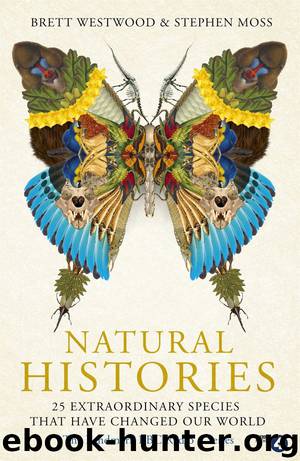Natural Histories by Brett Westwood & Stephen Moss

Author:Brett Westwood & Stephen Moss [Brett Westwood and Stephen Moss]
Language: eng
Format: epub
Publisher: Hodder and Stoughton
Published: 2015-09-01T04:00:00+00:00
yes, in spite of all,
Some shape of beauty moves away the pall
From our dark spirits. Such the sun, the moon,
Trees old and young, sprouting a shady boon
For simple sheep; and such are daffodils
With the green world they live in;
Keats, Endymion
13
Daffodils
Narcissistic Poetry
It’s late March and a rapier wind is doing its best to deny spring. We’re being tugged westwards, after checking Met Office reports and calendar to catch the flowers at their fleeting best. Our goal is a corner of Gloucestershire where the M50 burrows through oak and fir woods east of Ross-on-Wye. Get the timing right and they are obvious even at speed from the car, pale yellow stars over-brimming the coppice and spilling down the motorway embankments as if the wood were too full to hold them: wild daffodils.
Wild flowers have always nourished our senses as well as providing more tangible comforts in the form of herbal remedies and foods, but few have the daffodil’s power to get under our skin. Poets have famously fallen under their spell. Their charm may lie in the impertinence of their sudden appearance in the teeth of a March gale.
There’s also a disbelief, perhaps, that such a flamboyant flower is at large in our countryside: daffodils are as blowsy and exotic as the finest orchids. We can also measure our lives against their appearance. Like a spring snowfall, the delights of daffodils are short-lived, a bittersweet reminder of the year’s turning. They appear as blue-green stubs as early as January, pushing through the packed winter earth or snow, and as winter wanes the green pod-shaped flower buds extend beyond the leaves. Shaking off the dry papery sheath, the flower unfurls, a halo of half petals/half sepals called tepals surrounding the corona, better known as the trumpet. The sweet scent attracts pollinating insects, especially bumblebees and some hoverflies that cross-fertilise the flowers. For some people it’s the quintessence of spring, but for others it has a whiff of animal waste, because of chemicals known as indoles which not everyone can detect. Some even go as far as to warn of the risk of placing a vase of daffodils in a bedroom at night: a nasty headache in the morning. Happily daffodil hangovers aren’t a serious problem, but they are a reminder of the origins of its name. Narcissus derives from the Greek narcao, to numb.
Once native wild daffodils were common throughout the British Isles. The herbalist John Gerard described them as ‘having narrowe leaves, thicke, fat, and full of slimie juice; among the which riseth up a naked stalke smooth and hollow, of a foot high’ and noted that in the late sixteenth century they grew ‘almost everywhere through England’. They spread rapidly by seed and especially by division of the bulbs, leading to natural clumps as new plants arise around the parents.
Heading towards Gloucestershire, gardens are already bright in every shade of yellow, but these are cultivated plants. Along with the rose, the daffodil is probably the most malleable British wild flower. Over
Download
This site does not store any files on its server. We only index and link to content provided by other sites. Please contact the content providers to delete copyright contents if any and email us, we'll remove relevant links or contents immediately.
The Lonely City by Olivia Laing(4571)
Animal Frequency by Melissa Alvarez(4156)
All Creatures Great and Small by James Herriot(3988)
Walking by Henry David Thoreau(3685)
Exit West by Mohsin Hamid(3636)
Origin Story: A Big History of Everything by David Christian(3473)
COSMOS by Carl Sagan(3352)
How to Read Water: Clues and Patterns from Puddles to the Sea (Natural Navigation) by Tristan Gooley(3241)
Hedgerow by John Wright(3109)
How to Do Nothing by Jenny Odell(3103)
The Inner Life of Animals by Peter Wohlleben(3100)
How to Read Nature by Tristan Gooley(3080)
Project Animal Farm: An Accidental Journey into the Secret World of Farming and the Truth About Our Food by Sonia Faruqi(3019)
Origin Story by David Christian(2994)
Water by Ian Miller(2955)
A Forest Journey by John Perlin(2918)
The Plant Messiah by Carlos Magdalena(2750)
A Wilder Time by William E. Glassley(2690)
Forests: A Very Short Introduction by Jaboury Ghazoul(2671)
